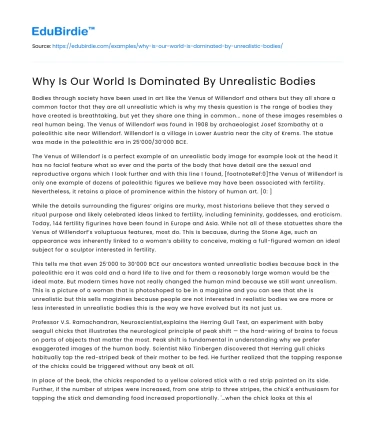Bodies through society have been used in art like the Venus of Willendorf and others but they all share a common factor that they are all unrealistic which is why my thesis question is The range of bodies they have created is breathtaking, but yet they share one thing in common... none of these images resembles a real human being. The Venus of Willendorf was found in 1908 by archaeologist Josef Szombathy at a paleolithic site near Willendorf. Willendorf is a village in Lower Austria near the city of Krems. The statue was made in the paleolithic era in 25’000/30’000 BCE.
The Venus of Willendorf is a perfect example of an unrealistic body image for example look at the head it has no facial feature what so ever and the parts of the body that have detail are the sexual and reproductive organs which I look further and with this line I found, [footnoteRef:0]The Venus of Willendorf is only one example of dozens of paleolithic figures we believe may have been associated with fertility. Nevertheless, it retains a place of prominence within the history of human art. [0: ]
Save your time!
We can take care of your essay
- Proper editing and formatting
- Free revision, title page, and bibliography
- Flexible prices and money-back guarantee
While the details surrounding the figures’ origins are murky, most historians believe that they served a ritual purpose and likely celebrated ideas linked to fertility, including femininity, goddesses, and eroticism. Today, 144 fertility figurines have been found in Europe and Asia. While not all of these statuettes share the Venus of Willendorf’s voluptuous features, most do. This is because, during the Stone Age, such an appearance was inherently linked to a woman’s ability to conceive, making a full-figured woman an ideal subject for a sculptor interested in fertility.
This tells me that even 25’000 to 30’000 BCE our ancestors wanted unrealistic bodies because back in the paleolithic era it was cold and a hard life to live and for them a reasonably large woman would be the ideal mate. But modern times have not really changed the human mind because we still want unrealism. This is a picture of a woman that is photoshoped to be in a magizine and you can see that she is unrealistic but this sells magizines because people are not interested in realistic bodies we are more or less interested in unrealistic bodies this is the way we have evolved but its not just us.
Professor V.S. Ramachandran, Neuroscientist,explains the Herring Gull Test, an experiment with baby seagull chicks that illustrates the neurological principle of peak shift — the hard-wiring of brains to focus on parts of objects that matter the most. Peak shift is fundamental in understanding why we prefer exaggerated images of the human body. Scientist Niko Tinbergen discovered that Herring gull chicks habitually tap the red-striped beak of their mother to be fed. He further realized that the tapping response of the chicks could be triggered without any beak at all.
In place of the beak, the chicks responded to a yellow colored stick with a red strip painted on its side. Further, if the number of stripes were increased, from one strip to three stripes, the chick's enthusiasm for tapping the stick and demanding food increased proportionally. '…when the chick looks at this elongated object with three red stripes it responds even more than it does to a natural beak.' 'I think there's an analogy here in that what's going on in the brains of our ancestors, the artists who were creating these Venus figurines were producing grossly … exaggerated versions, the equivalent for their brain of what the stick with the three red stripes is for the chick's brain.'
Refernces
- https://time.com/2934434/this-is-what-the-same-woman-looks-like-photoshopped-in-different-countries/
- https://mymodernmet.com/the-venus-of-willendorf/ (2017)
- My Modern Met. 2019. Venus of Willendorf: A 30,000-Year-Old Figurine That Continues to Captivate. [ONLINE] Available at: https://mymodernmet.com/the-venus-of-willendorf/. [Accessed 24 October 2019].
- https://www.khanacademy.org/humanities/prehistoric-art/paleolithic-art/a/venus-of-willendorf (Essay by Dr. Bryan Zygmont) accessed on the 24/10/2019)






 Stuck on your essay?
Stuck on your essay?

